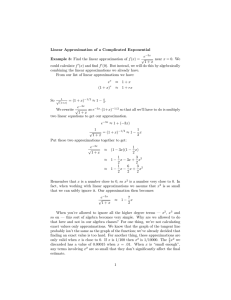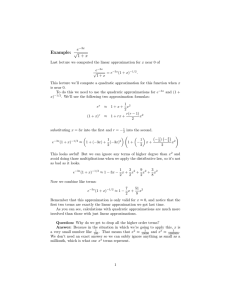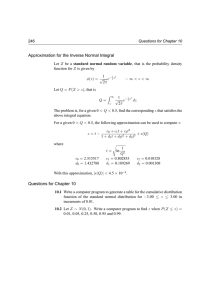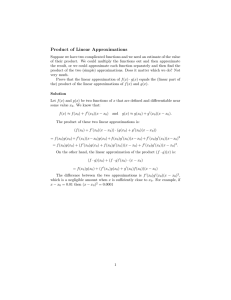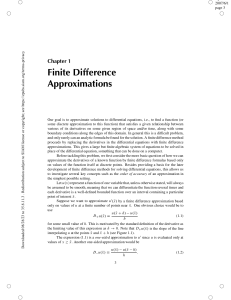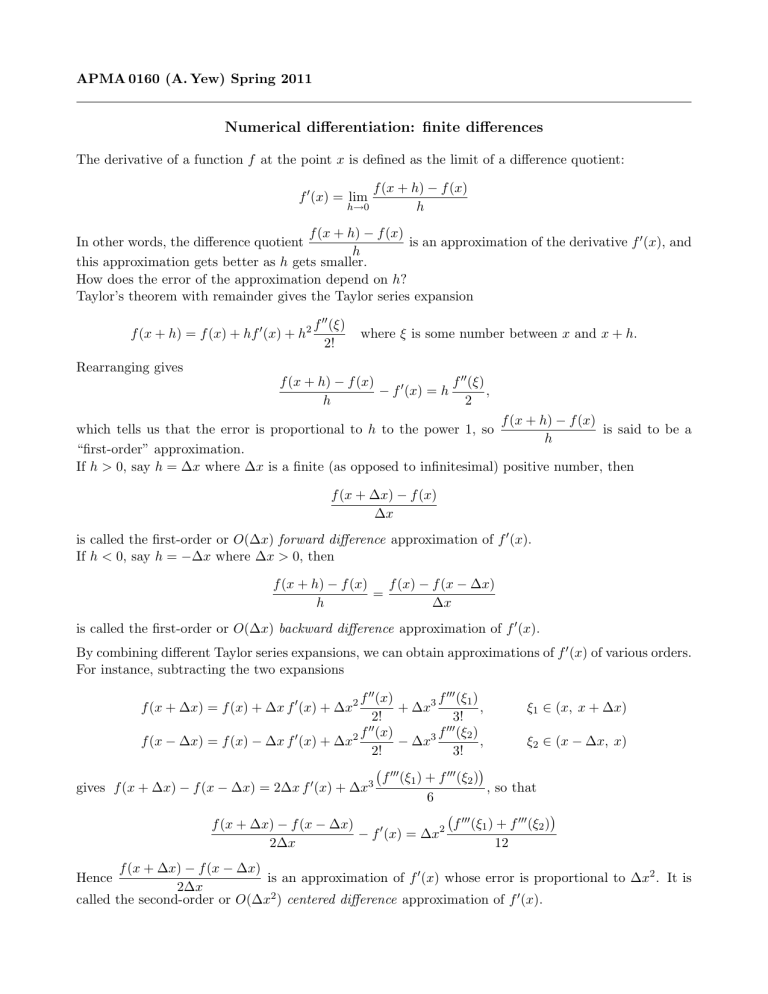
APMA 0160 (A. Yew) Spring 2011 Numerical differentiation: finite differences The derivative of a function f at the point x is defined as the limit of a difference quotient: f 0 (x) = lim h→0 f (x + h) − f (x) h f (x + h) − f (x) In other words, the difference quotient is an approximation of the derivative f 0 (x), and h this approximation gets better as h gets smaller. How does the error of the approximation depend on h? Taylor’s theorem with remainder gives the Taylor series expansion f (x + h) = f (x) + hf 0 (x) + h2 Rearranging gives f 00 (ξ) 2! where ξ is some number between x and x + h. f (x + h) − f (x) f 00 (ξ) − f 0 (x) = h , h 2 f (x + h) − f (x) which tells us that the error is proportional to h to the power 1, so is said to be a h “first-order” approximation. If h > 0, say h = ∆x where ∆x is a finite (as opposed to infinitesimal) positive number, then f (x + ∆x) − f (x) ∆x is called the first-order or O(∆x) forward difference approximation of f 0 (x). If h < 0, say h = −∆x where ∆x > 0, then f (x + h) − f (x) f (x) − f (x − ∆x) = h ∆x is called the first-order or O(∆x) backward difference approximation of f 0 (x). By combining different Taylor series expansions, we can obtain approximations of f 0 (x) of various orders. For instance, subtracting the two expansions f 00 (x) f 000 (ξ1 ) + ∆x3 , ξ1 ∈ (x, x + ∆x) 2! 3! f 00 (x) f 000 (ξ2 ) f (x − ∆x) = f (x) − ∆x f 0 (x) + ∆x2 − ∆x3 , ξ2 ∈ (x − ∆x, x) 2! 3! f 000 (ξ1 ) + f 000 (ξ2 ) 0 3 gives f (x + ∆x) − f (x − ∆x) = 2∆x f (x) + ∆x , so that 6 000 000 f (x + ∆x) − f (x − ∆x) 0 2 f (ξ1 ) + f (ξ2 ) − f (x) = ∆x 2∆x 12 f (x + ∆x) = f (x) + ∆x f 0 (x) + ∆x2 f (x + ∆x) − f (x − ∆x) is an approximation of f 0 (x) whose error is proportional to ∆x2 . It is 2∆x called the second-order or O(∆x2 ) centered difference approximation of f 0 (x). Hence If we use expansions with more terms, higher-order approximations can be derived, e.g. consider f 00 (x) f 000 (x) f (4) (x) f (5) (ξ1 ) + ∆x3 + ∆x4 + ∆x5 2! 3! 4! 5! 000 (4) (5) 00 f (x) f (x) f (ξ2 ) f (x) − ∆x3 + ∆x4 − ∆x5 f (x − ∆x) = f (x) − ∆x f 0 (x) + ∆x2 2! 3! 4! 5! 00 000 (4) f (x) f (x) f (x) f (5) (ξ3 ) f (x + 2∆x) = f (x) + 2∆x f 0 (x) + 4∆x2 + 8∆x3 + 16∆x4 + 32∆x5 2! 3! 4! 5! 000 (x) (4) (x) (5) (ξ ) 00 (x) f f f f 4 − 8∆x3 + 16∆x4 − 32∆x5 f (x − 2∆x) = f (x) − 2∆x f 0 (x) + 4∆x2 2! 3! 4! 5! f (x + ∆x) = f (x) + ∆x f 0 (x) + ∆x2 Taking 8 × (first expansion − second expansion) − (third expansion − fourth expansion) cancels out the ∆x2 and ∆x3 terms; rearranging then yields a fourth-order centered difference approximation of f 0 (x). Approximations of higher derivatives f 00 (x), f 000 (x), f (4) (x) etc. can be obtained in a similar manner. For example, adding f 00 (x) f 000 (x) f (4) (ξ1 ) f (x + ∆x) = f (x) + ∆x f 0 (x) + ∆x2 + ∆x3 + ∆x4 ··· 2! 3! 4! f 000 (x) f (4) (ξ2 ) f 00 (x) − ∆x3 + ∆x4 ··· f (x − ∆x) = f (x) − ∆x f 0 (x) + ∆x2 2! 3! 4! (4) (ξ ) + f (4) (ξ ) f 1 2 , so that gives f (x + ∆x) + f (x − ∆x) = 2f (x) + ∆x2 f 00 (x) + ∆x4 24 (4) (ξ ) + f (4) (ξ ) f (x + ∆x) − 2f (x) + f (x − ∆x) 1 2 00 2 f − f (x) = ∆x ∆x2 24 f (x + ∆x) − 2f (x) + f (x − ∆x) is a second-order centered difference approximation of the sec∆x2 00 ond derivative f (x). Hence Here are some commonly used second- and fourth-order “finite difference” formulas for approximating first and second derivatives: O(∆x2 ) centered difference approximations: f 0 (x) : f (x + ∆x) − f (x − ∆x) /(2∆x) f 00 (x) : f (x + ∆x) − 2f (x) + f (x − ∆x) /∆x2 O(∆x2 ) forward difference approximations: f 0 (x) : −3f (x) + 4f (x + ∆x) − f (x + 2∆x) /(2∆x) f 00 (x) : 2f (x) − 5f (x + ∆x) + 4f (x + 2∆x) − f (x + 3∆x) /∆x3 O(∆x2 ) backward difference approximations: 0 f (x) : 3f (x) − 4f (x − ∆x) + f (x − 2∆x) /(2∆x) f 00 (x) : 2f (x) − 5f (x − ∆x) + 4f (x − 2∆x) − f (x − 3∆x) /∆x3 O(∆x4 ) centered difference approximations: f 0 (x) : −f (x + 2∆x) + 8f (x + ∆x) − 8f (x − ∆x) + f (x − 2∆x) /(12∆x) f 00 (x) : −f (x + 2∆x) + 16f (x + ∆x) − 30f (t) + 16f (x − ∆x) − f (x − 2∆x) /(12∆x2 ) In science and engineering applications it is often the case that an exact formula for f (x) is not known. We may only have a set of data points (x1 , y1 ), (x2 , y2 ), . . . , (xn , yn ) available to describe the functional dependence y = f (x). If we need to estimate the rate of change of y with respect to x in such a situation, we can use finite difference formulas to compute approximations of f 0 (x). It is appropriate to use a forward difference at the left endpoint x = x1 , a backward difference at the right endpoint x = xn , and centered difference formulas for the interior points.


